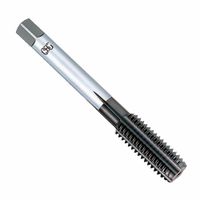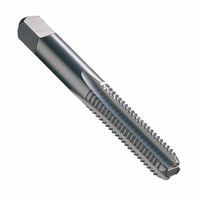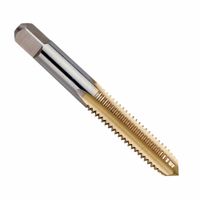Call +(254) 703 030 000 / 751 483 999 / 721 704 777
- Home
- Machining
- Threading
- Taps Internal Threading Tools
- Straight Flute Taps
.....Read More
Frequently Asked Questions
What are straight-flute taps used for?
Straight-flute taps are used primarily for cutting threads in through holes and blind holes in a variety of materials. They are designed with straight flutes that run parallel to the axis of the tap, which allows them to cut threads by shearing the material. This design is particularly effective for materials that produce short chips, such as cast iron, brass, and certain plastics.
The straight-flute design is advantageous in applications where chip evacuation is not a significant concern, as the chips are not directed out of the hole but rather accumulate in the flutes. This makes them suitable for materials that do not produce long, stringy chips that could clog the flutes. Additionally, straight-flute taps are often used in hand tapping operations due to their straightforward design and ease of use.
These taps are also commonly employed in situations where the workpiece is thin or where the material is brittle, as the straight flutes provide a stable cutting action that minimizes the risk of damaging the workpiece. Furthermore, straight-flute taps can be used in both manual and machine tapping operations, making them versatile tools in various manufacturing and repair settings.
In summary, straight-flute taps are ideal for threading applications in materials that produce short chips, and they are particularly useful in hand tapping and situations where chip evacuation is not a primary concern.
How do you choose the right tap material for a specific application?
To choose the right tap material for a specific application, consider the following factors:
1. **Workpiece Material**: Match the tap material to the workpiece material. For example, high-speed steel (HSS) taps are versatile and suitable for general-purpose applications, while cobalt taps are better for harder materials like stainless steel.
2. **Tapping Environment**: Consider the operating conditions. For high-temperature applications, taps with coatings like titanium nitride (TiN) or titanium carbonitride (TiCN) offer better heat resistance and wear protection.
3. **Production Volume**: For high-volume production, carbide taps provide longer tool life and maintain precision, reducing downtime for tool changes.
4. **Thread Type and Size**: The complexity and size of the thread can influence material choice. For small, intricate threads, a more precise material like carbide may be necessary.
5. **Machine Capability**: Ensure the tap material is compatible with the machine's capabilities. Carbide taps require rigid machines due to their brittleness.
6. **Cost Considerations**: Balance the cost of the tap material with its expected lifespan and performance. While carbide taps are more expensive, their durability can justify the cost in demanding applications.
7. **Coatings and Treatments**: Consider additional coatings or treatments that enhance performance. For example, black oxide coatings reduce friction and improve chip flow.
8. **Chip Evacuation**: For materials that produce long chips, spiral point or spiral flute taps made from durable materials can improve chip evacuation and prevent tap breakage.
By evaluating these factors, you can select a tap material that optimizes performance, cost, and tool life for your specific application.
What is the difference between carbide and high-speed steel taps?
Carbide taps and high-speed steel (HSS) taps are both used for cutting threads, but they differ in material composition, performance, and application.
Carbide taps are made from tungsten carbide, a very hard and wear-resistant material. They are ideal for high-speed applications and can maintain a sharp cutting edge for longer periods, making them suitable for hard materials like stainless steel, titanium, and cast iron. Carbide taps offer excellent heat resistance, allowing them to perform well in high-temperature environments. However, they are brittle and can break easily under improper use or in interrupted cuts.
High-speed steel taps, on the other hand, are made from an alloy of steel that includes elements like tungsten, molybdenum, and chromium. HSS taps are more flexible and less brittle than carbide taps, making them more forgiving in less-than-ideal conditions. They are suitable for a wide range of materials, including softer metals like aluminum and mild steel. HSS taps are generally more cost-effective and can be used in both manual and machine operations. They are less wear-resistant compared to carbide taps but offer good toughness and can withstand shock and vibration.
In summary, carbide taps are preferred for high-speed, high-volume production and hard materials, while HSS taps are versatile, cost-effective, and suitable for general-purpose applications.
How do you properly use a hand tap to create internal threads?
1. **Select the Tap and Drill**: Choose the correct tap size for the desired thread and use the corresponding drill bit to create the initial hole.
2. **Drill the Hole**: Secure the workpiece and drill a hole perpendicular to the surface. Ensure the hole is slightly larger than the tap's minor diameter.
3. **Secure the Tap**: Place the tap in a tap wrench, ensuring it is centered and secure.
4. **Align the Tap**: Position the tap perpendicular to the hole to prevent cross-threading.
5. **Start Tapping**: Apply cutting fluid to the tap and hole to reduce friction. Insert the tap into the hole and turn it clockwise with gentle pressure.
6. **Cut the Threads**: Turn the tap 1/4 to 1/2 turn forward, then reverse slightly to break chips. Continue this process, ensuring the tap remains aligned.
7. **Clear Chips**: Periodically remove the tap and clean out chips to prevent clogging and damage.
8. **Complete the Threading**: Continue tapping until the desired depth is reached. For through holes, tap until the tap exits the other side.
9. **Remove the Tap**: Carefully reverse the tap out of the hole, ensuring not to damage the newly cut threads.
10. **Clean the Threads**: Use a brush or compressed air to remove any remaining chips or debris from the threads.
11. **Inspect the Threads**: Check the threads for uniformity and fit using a thread gauge or the mating part.
12. **Lubricate if Necessary**: Apply lubricant to the threads if the application requires it for assembly or operation.
What are the advantages of using powdered-metal taps?
Powdered-metal taps offer several advantages:
1. **Durability**: Powdered-metal taps are made from a composite of metal powders, which are sintered to form a dense, uniform material. This process enhances the tap's toughness and resistance to wear, extending its lifespan compared to conventional taps.
2. **Strength**: The sintering process used in powdered-metal taps results in a material with superior mechanical properties, including higher tensile strength and resistance to chipping or breaking under stress.
3. **Precision**: The uniformity of the powdered-metal composition allows for precise manufacturing, resulting in taps with consistent dimensions and cutting performance. This precision is crucial for producing accurate threads.
4. **Heat Resistance**: Powdered-metal taps can withstand higher temperatures without losing hardness, making them suitable for high-speed tapping operations and materials that generate significant heat during machining.
5. **Versatility**: These taps can be used on a wide range of materials, including hard-to-machine alloys, due to their enhanced cutting capabilities and durability.
6. **Cost-Effectiveness**: Although initially more expensive, the extended tool life and reduced need for replacements make powdered-metal taps cost-effective in the long run.
7. **Improved Surface Finish**: The superior cutting edge and material properties contribute to a better surface finish on the threads, reducing the need for additional finishing processes.
8. **Reduced Tool Breakage**: The enhanced toughness and strength minimize the risk of tool breakage, leading to fewer interruptions in production and lower maintenance costs.
9. **Environmental Benefits**: The manufacturing process of powdered-metal taps is more efficient, with less material waste compared to traditional methods, contributing to more sustainable production practices.
How do you prevent tap breakage when tapping hard materials?
To prevent tap breakage when tapping hard materials, consider the following strategies:
1. **Material Selection**: Use taps made from high-speed steel (HSS) or carbide, which are more durable and suitable for hard materials.
2. **Proper Tap Type**: Choose the right tap type, such as spiral point taps for through holes or spiral flute taps for blind holes, to efficiently remove chips.
3. **Correct Tap Size**: Ensure the tap size matches the hole size to avoid excessive force and potential breakage.
4. **Lubrication**: Apply appropriate cutting fluids or lubricants to reduce friction and heat, which can lead to tap failure.
5. **Speed and Feed**: Use the correct speed and feed rates. Slower speeds and appropriate feed rates help maintain control and reduce stress on the tap.
6. **Peck Tapping**: For deep holes, use peck tapping to periodically retract the tap, clearing chips and reducing heat buildup.
7. **Alignment**: Ensure the tap is aligned correctly with the hole to prevent side loading and uneven stress distribution.
8. **Machine Condition**: Use well-maintained machines with minimal spindle runout to ensure precision and reduce the risk of breakage.
9. **Hole Preparation**: Drill holes to the correct size and depth, and deburr edges to facilitate smooth tap entry.
10. **Chip Evacuation**: Ensure efficient chip removal to prevent clogging and binding, which can cause tap breakage.
11. **Tapping Attachments**: Use floating or tension-compression tapping holders to compensate for minor misalignments and reduce stress on the tap.
12. **Operator Skill**: Ensure operators are trained and experienced in tapping hard materials, as skilled handling can significantly reduce breakage risks.
By implementing these strategies, you can effectively minimize the risk of tap breakage when working with hard materials.
What maintenance is required for straight-flute taps to ensure longevity?
To ensure the longevity of straight-flute taps, regular maintenance is essential. First, keep the taps clean by removing chips and debris after each use. Use a soft brush or compressed air to clear the flutes and cutting edges. Second, inspect the taps for wear and damage, such as chipped or dull cutting edges, and replace them if necessary. Third, ensure proper lubrication during use to reduce friction and wear; apply cutting oil or a suitable lubricant to the tap and workpiece. Fourth, store the taps in a dry, organized environment to prevent rust and damage. Use protective cases or holders to avoid contact with other tools. Fifth, periodically check the alignment and condition of the tap holder and machine spindle to prevent misalignment and excessive wear. Sixth, sharpen the taps when they become dull, using appropriate sharpening tools or services to maintain cutting efficiency. Lastly, follow the manufacturer's guidelines for speed and feed rates to prevent overloading and overheating, which can lead to premature wear. Regular maintenance and proper handling will extend the life of straight-flute taps.





